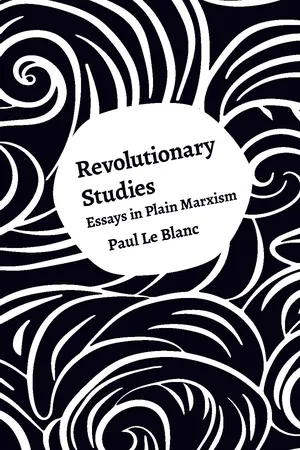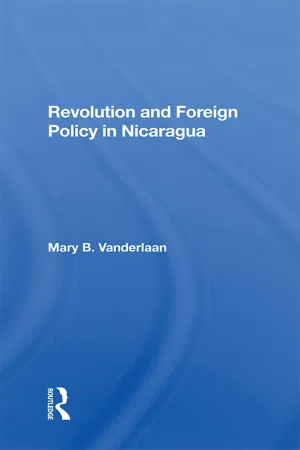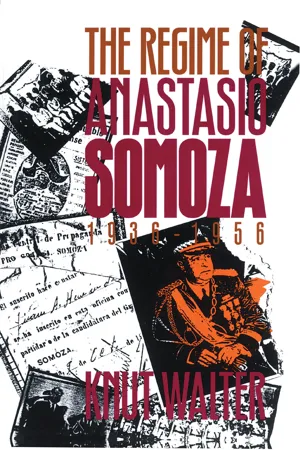History
US Occupation of Nicaragua
The US occupation of Nicaragua refers to the period from 1912 to 1933 when the United States military intervened in Nicaragua to protect American interests and influence the country's political and economic affairs. This intervention led to significant social and political unrest in Nicaragua and was met with resistance from Nicaraguan nationalist forces. The occupation ultimately ended with the withdrawal of US troops in 1933.
Written by Perlego with AI-assistance
Related key terms
Related key terms
1 of 4
Related key terms
1 of 3
5 Key excerpts on "US Occupation of Nicaragua"
- eBook - ePub
Revolutionary Studies
Theory, History, People
- Paul Le Blanc(Author)
- 2018(Publication Date)
- Haymarket Books(Publisher)
1By the end of the nineteenth century, the United States was unquestionably the dominant power in the Western Hemisphere, but the so-called Open Door foreign policy precluded US government and business leaders from seeking to make Nicaragua an outright colony. Rather, they sought to advance their interests by ensuring the existence in Nicaragua of friendly governments through “gunboat diplomacy” that involved frequent military interventions throughout much of Latin America and the Caribbean.2It was in reaction to such US military intervention that the plebian radical nationalist Augusto César Sandino led an immensely popular and very successful guerrilla war in the 1920s and early 1930s. His troops were made up of peasants and workers. Influenced by diverse ideological currents, Sandino explained to mine workers in 1926 “the sad fact that we were exploited and we ought to have a government really concerned for the people to stop the vile exploitation by the capitalists and big foreign enterprises.” Sandino was able to outfight and confound US military forces, becoming a hero throughout Latin America and an international symbol of anti-imperialism.3The most perceptive and influential foreign policy-makers in the US government concluded, by the 1930s, that such direct intervention into the political life of countries such as Nicaragua was becoming counterproductive. The so-called Good Neighbor Policy of President Franklin D. Roosevelt was a reflection of this change, but it had been initiated earlier under the Republican administration of Herbert Hoover, whose State Department personnel fashioned a new policy mandating an independent and constitutional Nicaraguan government, in which a stable two-party system (with the Liberal and Conservative parties) would be established, US military forces withdrawn (as Sandino demanded), the US interventionist pattern terminated, and a US-trained Nicaraguan National Guard established to maintain law and order and political stability. Then a durable “Good Neighbor” relationship could more effectively maintain US economic interests in the region.4 - eBook - ePub
- Mary Vanderlaan(Author)
- 2019(Publication Date)
- Routledge(Publisher)
Yanquis "--figured prominantly in that history. Sent by Washington to impose its brand of "civility," to replace an uncooperative bourgeois faction with a more cooperative one or to crush popular revolts, the marines landed in Nicaragua in 1893, 1894, 1895, 1896, 1898, 1909, 1912, and 1925. In 1912 and up to 1925 a garrison of about 100 marines was stationed in Nicaragua. In 1925 many more marines occupied Nicaragua to quell a civil war after US Secretary of State Frank Kellogg warned of a threat of "Soviet Bolshevism" there. Popular guerrilla uprisings against US domination led by General Sandino thereafter were viewed as a threat to US interests--e.g. under the Bryan-Chamorro Treaty of 1914 Nicaragua had ceded to the United States a long-term option to construct a canal through Nicaraguan territory. Nicaraguan territory also constituted the heartland of what the United States considered its "soft underbelly" region. Political conformity and stability there was assumed to be in the US national interest. The marines' struggles against Sandino's forces from 1927 to 1932, in fact, constituted the United States' first counterinsurgency war in Latin America. That war included the aerial bombardment of Ocatal in 1927, a battle in which 300 Nicaraguans died.Before the marines were recalled from Nicaragua in 1934 under FDR's Good Neighbor Policy they trained and armed a surrogate force--the Nicaraguan National Guard, under the direction of General Anastasio Somoza Garcia. It was Somoza's Guardia which assassinated General Sandino in 1934 as he left a dinner meeting with Somoza, and, after he had laid down arms. And it was the Guardia which was to symbolize for Nicaraguans both the ruthlessness of the Somoza family and that family's link to the United States. For 46 years the Guardia was key to the Somozas' power. During that period the Untied States trained and equipped the military force which the Somozas used to silence political dissenters. Indeed, bolstered by US support the Somoza family dominated Nicaraguan politics until 1979.Nicaragua's role in the informal alliance with the United States, meanwhile, was to play the reliable ally--in UN voting, in providing staging areas for CIA assaults against Guatemala (1954) and Cuba (1961); in operating as the backbone of the 1960s regional anti-communist alliance (CONDECA); in acting as the lynchpin in CONDECA's system of repressing regional popular movements; and the like. The United States' interests in Nicaragua historically were defined more by strategic than economic concerns.1 - eBook - ePub
The United States and Latin America
A History with Documents
- Jeffrey Taffet, Dustin Walcher(Authors)
- 2017(Publication Date)
- Routledge(Publisher)
One may well wonder why there has been such a change in Liberal opinion. Two factors are primarily responsible: the economic benefit that has come to Nicaragua…; and the growing confidence in the friendliness of the United States, convincing all elements in Nicaragua that no American conquest is in contemplation. This much is surely a great achievement! The United States obtains the purely negative advantage of protection of her citizens, and safeguarding of the Monroe Doctrine. Beyond this it is plainly to her interests not to go. Not only is a realization of this dawning in Nicaragua, but there is also a glimmer of appreciation of that fact in the other Central American countries. Guatemala, Salvador and Costa Rica are just now negotiating loans that must involve a similar penetration of American interest, if the loans go through. Eventually, it is to be hoped, it will be possible to bring about an entire withdrawal of American control without risk of revolution and a total upsetting of political and financial stability. The day that the severing of the American connection shall come depends upon the Nicaraguans themselves.Document 3.11
James Weldon Johnson, Government of, by, and for the National City Bank, 1920The Executive Director of the National Association for the Advancement of Colored People (NAACP), James Weldon Johnson wrote articles in The Nation based on his travels in Haiti. More than any other journal, The Nation covered the intricacies of US involvement in the Caribbean and Central America.11Former articles of this series described the Military Occupation of Haiti and the crowd of civilian place holders as among the forces at work in Haiti to maintain the present status in that country. But more powerful though less obvious, and more sinister, because of its deep and varied radications, is the force exercised by the National City Bank of New York. It seeks more than the mere maintenance of the present status in Haiti; it is constantly working to bring about a condition more suitable and profitable to itself. Behind the Occupation, working conjointly with the Department of State, stands this great banking institution of New York and elsewhere. The financial potentates allied with it are the ones who will profit by the control of Haiti. The United States Marine Corps and the various office-holding “deserving Democrats,” who help maintain the status quo there, are in reality working for great financial interests in this country, although Uncle Sam and Haiti pay their salaries. - eBook - ePub
- Knut Walter(Author)
- 2000(Publication Date)
- The University of North Carolina Press(Publisher)
22 That is, instability and undemocratic procedures were the product of years of educational backwardness and disrespect for law and decency. But that does not explain the root causes of political conflict. A more plausible explanation should concentrate on the issues involved in the conflicts of the period, and not just the superficial manifestations such as electoral fraud, civil war, and foreign intervention. After all, the Liberal party was active during all the years of Conservative rule, seeking to broaden its base of support. For what purpose, if not to achieve a takeover of the government?The Nicaraguan political crisis of 1910-27, which corresponded to the years of U.S. protectorate status, was in reality a crisis of the state itself. Although not expressed clearly in political platforms and programs, basic differences existed among the groups that competed for control of the government. The United States, in turn, which had more control over the government than any Nicaraguan political faction, was seeking to establish political stability in Nicaragua through institutional development and political procedures (both electoral and legislative) that would guarantee participation to both historic parties. U.S. policy did not favor one party over another because of ideological preference; what the United States wanted was a government that could establish effective control over the national territory, that would not create trouble among its neighbors, that would protect U.S. canal rights across Nicaragua, and that, in sum, would be subservient to Washington’s interests in the region.23From 1911 to 1927, the Nicaraguan faction that was willing to do whatever the United States required was the Conservative party because it knew that support from Washington was vital to maintain its hold on the government. But there was no fundamental quarrel between the Conservatives and U.S. interests in Nicaragua, either. That U.S. corporations took over control of the national railroad and the national bank and that U.S. officials collected customs duties and determined government expenditures was of no great concern to the Conservative oligarchy from Granada. Not even national sovereignty meant much to the Conservatives who signed the Bryan-Chamorro Treaty in exchange for three million dollars. The fact of the matter was that Conservative government policy, in line with U.S. interests, was geared fundamentally to ensuring fiscal solvency and public order. The Conservatives’ vision of the state, therefore, was in line with that which they had preached since the days of independence from Spain: a strong role for regional power brokers (caudillos), minimum government participation in developing the country’s infrastructure, and the defense of traditional values in the face of secular forces that threatened to abolish religious education and undermine the sanctity of the family through civil marriage and divorce. The government itself would serve primarily as a dispenser of limited public employment and as the medium for conciliation of political differences that could not be settled at lower levels. - eBook - ePub
Not Condemned To Repetition
The United States And Nicaragua
- Robert Pastor(Author)
- 2018(Publication Date)
- Routledge(Publisher)
One reason for the Sandinista victory in 1979 was that many thought the United States would prevent it, but no one acted on that assumption. All the key actors in the region thought the United States could control everyone else's behavior—except their own. The United States was perceived to be at the center of events, but that was an illusion—to which even the United States fell victim.Although much of the literature on the Nicaraguan revolution views the United States as the actor and Nicaragua as the object, a much more complicated interaction occurred. The United States was at the center of the region's consciousness, but Nicaraguans always remained at the center of events. Though the United States is vastly more powerful than the nations of Central America, one should not assume that such power automatically translates into influence. Indeed, such power is sometimes reversible, with leaders or groups in the region using the United States to further their own political or economic ends, while ignoring U.S. attempts to influence them.Some have found this role reversal difficult to interpret. For example, in summarizing U.S.-Nicaraguan relations over a forty-year period, LaFeber concluded: "As every President after Hoover knew, [the] Somozas did as they were told,"31 It is true that in order to strengthen their internal position, the Somozas cultivated the myth that they were working for the United States, but it was only a myth. The Somozas were no one's fools or servants. They cooperated with the United States only when it was in their interest to do so.The roots of the revolution's radicalization were in the minds of the Sandinista and North American leaders. The different histories and deep suspicions each had of the other led each to perceive defensive actions as provocative ones. Both sides made policies that consistently evoked the worst in the other.The repetitive policies of each of the actors also grew out of their national experience—each nation's history and political culture. This explains the continuity in each policy, but there were also some important changes over time, due in part to different leaders with markedly different perceptions of the nature and intensity of the threat to their national interests.
Index pages curate the most relevant extracts from our library of academic textbooks. They’ve been created using an in-house natural language model (NLM), each adding context and meaning to key research topics.
Explore more topic indexes
Explore more topic indexes
1 of 6
Explore more topic indexes
1 of 4




